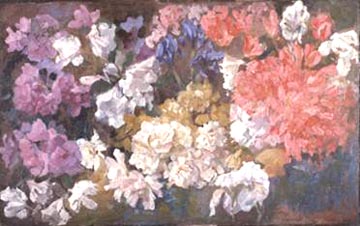
Piet Mondrian
Dutch, 1872-1944
Rhododendron, 1905
oil on canvas
SBMA, Margaret Abbott Memorial Fund
1963.10
RESEARCH PAPER
Piet Mondrian received early training in art from his uncle. He then studied at the Academy in Amsterdam for a strong academic ground work.
Mondrian's early works were characteristic of the Dutch version of the Barbizon school. He worked out of doors. He showed a boldness of experimentation even in this early naturalistic period. Unlike his contemporaries he preferred dark days with sombre colors and dark tonality. He painted ordinary objects realistically and avoided action. He did have an occasional impressionistic work and was captured the natures senuous beauty as can be seen in his flower series (1900-1910). He did land and seascapes throughout this naturalistic period with a special interest in wind and waves.
The first element to change in Mondrian's paintings was color. He left natures colors for pure colors. He felt that no artist could reproduce the colors found in nature, He used bright pigments and later as his works continued to develop he came to use only the primary colors (1920-1921).
Mondrian's subject matter became less descriptive in 1907-08. His brush strokes becamse more broad.
During the period of 1908 to 1910 Mondrian's paintings became more abstract. His style was developing from naturalism to abstraction. He began to exhibit horizontal dominance, as in his seascapes, and a vertical dominance, as in his series of churches.
Throughout his naturalistic period Mondrian often completed a series of a single subject such as his series of flowers, trees, windmills, haystacks and churches. These series were a transitional period as Mondrian moved toward cubism and a final break with naturalism in 1912. Mondrian's growth into abstraction can be seen in his trees. The series begins with a realistic representation of a tree and through the series develops to an abstraction. Mondrian was interested in the visual organization of a tree not its actual three-dimensional form. His growing concern with line can be seen in this series.
Mondrian traveled to Paris in December of 1911. He studied the work of the French Cubists and developed his owm interpretation of cubism. His goal in fragmentation was not to build up an object but rather to take and object and reduce its natural form to the most basic components.
To Mondrian the right angle was the only constant relationship and the horizontal and vertical lines were the most basic elements.
Mondrian began to eliminate curved lines. Late in 1914 he did a series of works of the sea. He placed the piers in the center going up into the picture to form a vertical. His compositions began to contain horizontal and vertical lines which crossed. These were abstractions of the sea and sky.
Mondrian felt that nature is a form or forms in space and therefore nature (reality) must consist of form and space. He used the elements of horizontals, verticals, rectangles, black and white and primary colors in his search for harmony of this form and space. Black and/or white referred to space with red, blue or yellow representing form. Mondrian stressed balance. Numerous of his later works were variations of the balance of lines and shapes (an example is "Composition in Red , Blue and Yellow. " )
In his later years Mondrian developed a strong aversion to nature. He seemed to feel nature had a power over the human mind and creative processes. He tried to keep his idea of beauty unaffected by nature's beauty.
Mondrian continually experimented. His art was never static. It was always evolving. He progressed through the elimination of color planes (large areas of primary color representing form) in a series of works (1918-1919) and them back to the use of color planes. In the 1930's Mondrian's work became more complex but he returned to less complex works (1935-38). He did more work with color planes, some of these were not bounded by black lines. He experimented with the use of colored tape or charcoal for the boundaries. Mondrian's art was dominated by the fundamental principle of the balance of opposing forces represented by horizontal and vertical lines and he continued to strive for their perfect balance until the end of his life.
Mondrian's Rhododendron is an oil on canvas measuring 17" x 26 3/4". It was painted in 1905 during Mondrian's flower series (1900-1910). Many of the paintings in the fIower series were of a single flower as in the "Chrysanthemum". However, the "Rhododendron" is a mass of flowers covering the picture plane. Like the rest of the flower series, the colors of the "Rhododendron" are brighter than those Mondrian used in his earlier works. The colors are highkeyed, nature's own colors. There are dominant pinks and mauve with some gold, white, green and blue. There is a brilliant splash of hot pink on the right. The other colors are soft. Mondrian's interest in color can be seen in this early work. The color leads your eye through the painting in a circular pattern. It is an interesting comparison to Mondrian's later works where he tried to completely isolate his ideal beauty from the beauty of nature. In his later life Mondrian wrote that he always painted realistically and had never painted romantically. While that may have been his intention it would be difficult for any viewer to ignore the senuousness of nature's beauty as it is seen in the "Rhododendron".
Mondrian's beginning development into abstraction can be seen in his handling of this work. The brush strokres are large and fluid. The overall feeling is of a loose painterly style.
Bibliography on file
Prepared for the Docent Council of the SBMA 1975, LynAnn G. Eye
